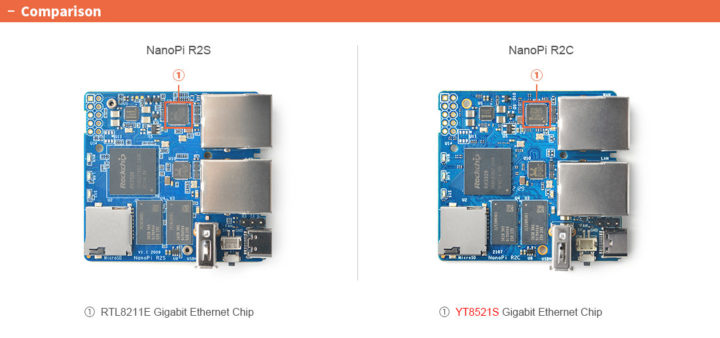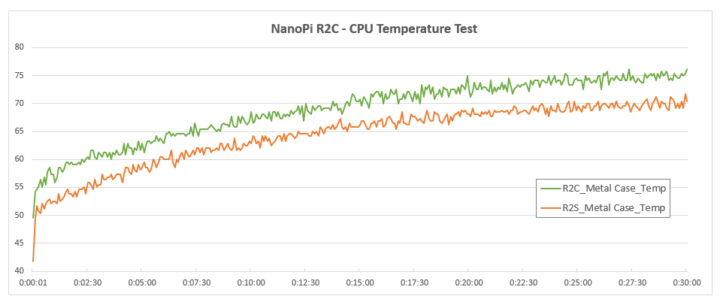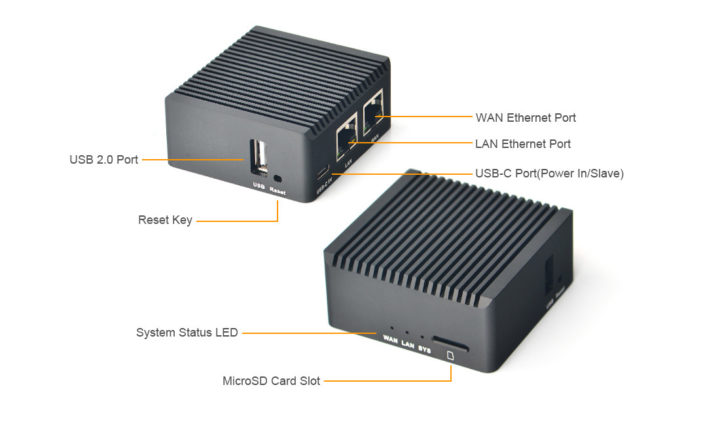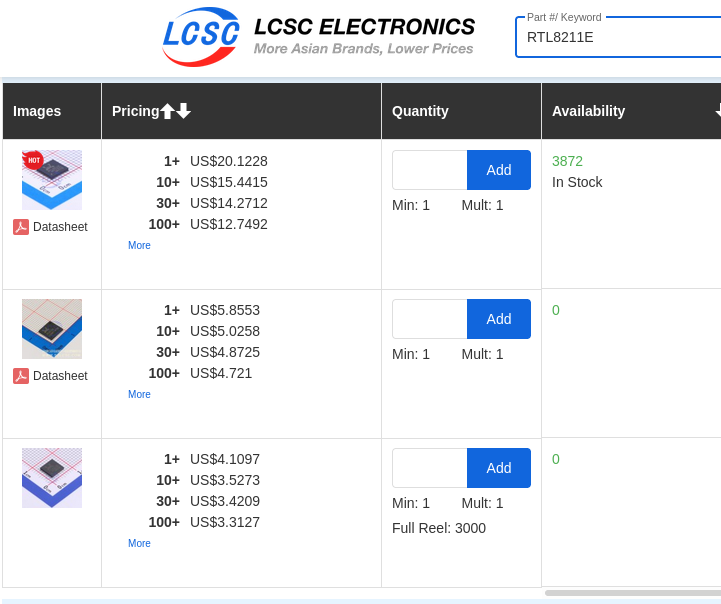FriendlyELEC’s NanoPi R2C is an updated version of NanoPi R2S dual GbE mini router that replaces Realtek RTL8211E Gigabit Ethernet transceiver with a Motorcomm YT8521S chip.
NanoPi R2C mini router still comes with a Rockchip RK3328 quad-core Cortex-A53 processor, 1GB DDR4 memory, and a Realtek RTL8153 USB 3.0 to Ethernet controller for the second Ethernet port.
- SoC – Rockchip RK3328 quad-core Cortex-A53 @ 1.5 GHz with Arm Mali-450MP2
- System Memory – 1GB DDR4 RAM
- Storage – MicroSD Slot, SPI flash footprint
- Connectivity
- 1x Gigabit Ethernet (WAN) up to 941 Mbps (measured) via MotorComm YT8521S Gigabit Ethernet transceiver
- 1x Gigabit Ethernet (LAN) up to 941 Mbps (measured) via Realtek RTL8153 USB 3.0 to Ethernet controller
- USB – 1x USB 2.0 Type-A host port, USB Type-C port
- Debugging – 3-pin 2.54mm pitch header for serial console
- Expansion – 10-pin GPIO header with GPIOs, I2C, UART, IR_Rx, 5V, 3.3V and GND
- Misc – 3x LEDs (WAN, LAN, SYS), K1 reset button, fan header
- Power Supply – 5V/4A DC via USB-C port
- Dimensions – Router: 60 x 60 x 29.5 mm; SBC: 55.6 x 52mm
- Weight – About 76 grams with enclosure
- Temperature Range – -20 to 70
 The company reports the only difference is the Gigabit Ethernet chip, but when I reviewed NanoPi R2S with Armbian last year, it still had a micro USB port for power, so they may have changed it to USB-C in the most recent revision.
The company reports the only difference is the Gigabit Ethernet chip, but when I reviewed NanoPi R2S with Armbian last year, it still had a micro USB port for power, so they may have changed it to USB-C in the most recent revision.
FriendlyELEC still claims the measured performance is the same, e.g. 941 Mbps with iperf with the new chip, but the system runs a little warner albeit still within an acceptable temperature that does not accept the CPU performance.
 The chart above was performed in a room with a 24°C ambient temperature, with the system under full load, and the CPU frequency kept at 1.5 GHz the whole time. The results may be different in environments with a significantly higher ambient temperature.
The chart above was performed in a room with a 24°C ambient temperature, with the system under full load, and the CPU frequency kept at 1.5 GHz the whole time. The results may be different in environments with a significantly higher ambient temperature.
You may wonder why FriendlyELEC made the change… I don’t it boils down to this year’s semiconductors supply and cost issues. Last year, NanoPi R2S sold for $25 with the board, and $32.99 with the metal enclosure, and now the price has gone up to $45.90 for the latter.
It’s easy to see why, as checking for RTL8211E availability on LCSC shows the only place with stock sells the chip for about $20 per unit, or $12.7492 per piece for 100 or more units order, which would represent a significant part of the BoM cost. The “normal” price for RTL8211 chip used to be under $1.
Motorcomm is a fairly new (2017) company based in Suzhou, China, and I can not find YT8521S for sale online, but it must be much cheaper and possibly compatible with than RTL8211E, which allows NanoPi R2C to be sold for $39 with the metal case. FriendlyELEC does not offer NanoPi R2C as an SBC only. As usual, you’ll find documentation on the Wiki.

Jean-Luc started CNX Software in 2010 as a part-time endeavor, before quitting his job as a software engineering manager, and starting to write daily news, and reviews full time later in 2011.
Support CNX Software! Donate via cryptocurrencies, become a Patron on Patreon, or purchase goods on Amazon or Aliexpress







I’ve finally found some resources Linux drivers, schematics, datasheets for YT8521S.
https://github.com/cnxsoft/YT8521S/
They seem to have drivers for integration into to Rockchip SoC specifically…
I can see Quartz64 is using a another Motor-comm PHY: YT8511 and it’s getting mainlined: https://lwn.net/Articles/856283/
There was once a time when realtek used to be this unknown newcomer, supplying the (then much smaller ICT-)world with cheap NE2000 clones
It’s a great move to abandon chips that cannot reasonably be sourced. I suspect that some vendors are taking the opportunity of the worldwide supply shortage to increase their prices, knowing that their customers often have no other option. At least this will send them a signal that if it was intentional it was not necessarily a good idea.
Still think they should of added a HDMI out ( mini signage, information display ).
A S905D3 2GB version with MIPI DSI, CSI, TP, HDMI and M.2 slot ( Khadas are concentrating on Mini PC, no harm in that ? ). Would open the market but with present parts prices, guess will not happen.
Same cost issues with RK3399, looking at Friendlyelec RK3399 board prices.
But that’s a completely different machine and use case, it’s like asking for an HDMI output on a router to watch movies while they’re routing packets.
What is missing, however, as a headless machine, is an externally accessible console port, because when you lose access to your device or forget its IP address, you have to get back to the screwdriver and figure where you’ve stored your USB-UART adapter. The lack of console port also prevents using it as a bridge or transparent firewall between the switch and a host, since you have no way to watch what is happening :-/
Regarding RK3399, they already offer one, look at R4S. I have one and it’s a nice box, except that I never use it since it lacks the serial port :-/
/u/Willy
Agreed on the observation about the missing accessible serial console. Has another vendor addressed this shortfall?
I’ve often wondered if it is because they don’t want to devote space to a DB9 or even RJ45 connector which are the choices in networking gear. Has someone defined a serial pinout for say a RJ11 connector?
Somebody else had the same idea ? sadly that companies reputation is not good on software etc.
Banana Pi BPI-M2S
Via liliputing today.
Usually you can use the USB OTG port to offer a serial console, but since it is also the power source, you are stuck either powering it from a USB Host, or else using a USB splitter to inject power from mains, and still allowing you to connect a USB Host to it when needed.
Very close and yet very far. This is great for mangling packets at gigabit speeds or for some firewall affairs.
But it would have been nice if they had hubbed the USB 3.0, and put a 3.0 port alongside USB 2.0. At 5 Gbps, a hubbed USB 3.0 port would have given far more adaptability. Even with Gig-E running 1-2.5 Gbps of overhead, that’s still 2.5+ Gbps of bandwidth on the USB 3.0 bus left over.
Instead it’s port limited to 480 Mbps on the USB 2.0 bus. You could have even put a compliance note like “USB 3.0 2.5 Gbps” on the side.
It’s unlikely both ports will agree on a fair sharing model of the bandwidth.
So your super duper USB SSD might starve the USB GbE
I wasn’t referring to SSD, but 5G phones certainly can exceed 480 Mbps over USB tethering.
That’s not how USB works. There’s no way to dedicate bandwidth to a specific device, it’s always shared.
It would have been far better to give the user a choice. Like using a 5G phone over USB, I wasn’t talking about SSD or other flooding use cases. There are many USB 3 use cases where it would have been 1:1 or similar – and quite functional.
Highly unlikely a Gig-E connection would be blocked from sharing.
Quite enough for a router, though. Let’s not forget it is not a NAS. To me, it seems to be the perfect host for my LTE modem. Right now I have it on my ODROID HC1, which is by all means overkill for such a task.
If you plug a 5G phone in over USB, it isn’t.
OK, now you will have to explain to me, how you are going to use Android or iOS phone as a USB modem on a Linux device.
Never heard of RNDIS? 5G is irrelevant, tethering over USB is not new.
Hmmm. $42 for 2x ~900Mb/s Ethernet and no wireless? This product looks great, but I’ll stick with something that has a little bit better value. Maybe prices will get a bit better when the chip shortage abates, whenever that is…